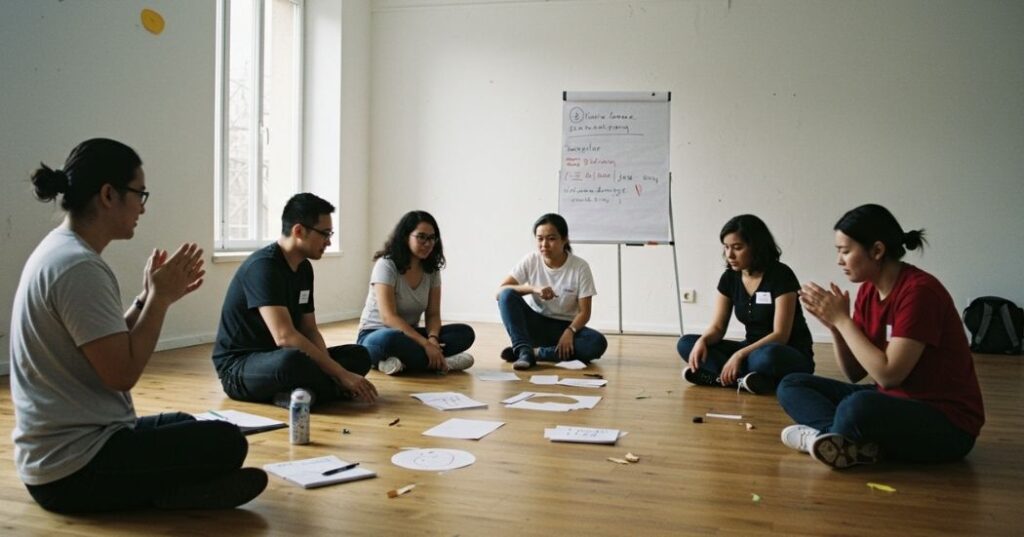“I’m not good enough.” “What if I fail again?” “Everyone else seems to have it all together.”
These thoughts don’t make you broken. They make you human. But you don’t have to stay stuck in them. Self-doubt is a common experience, but it doesn’t have to dictate your actions or define your potential.
With the right growth mindset exercises, you can actively train your brain to think differently—more kindly, more confidently, more powerfully. These practices are designed to cultivate genuine, lasting confidence from within, helping you leverage the power of a growth mindset to overcome inner critics and achieve your full potential.

🌱 What Is a Growth Mindset?
Coined by world-renowned psychologist Dr. Carol Dweck of Stanford University, a growth mindset is the profound belief that your abilities, intelligence, and talents are not fixed traits. Instead, they are qualities that can grow, develop, and be strengthened through dedicated effort, strategic learning, constructive feedback, and persistent practice. It stands in stark contrast to a fixed mindset, which holds that abilities are inherent and unchangeable.
“Becoming is better than being.” – Carol Dweck
This powerful quote encapsulates the essence of a growth mindset. It’s not about achieving a static state of “being” confident or “being” successful. Rather, it’s about the ongoing process of becoming—constantly learning, improving, and evolving. This mindset isn’t about pretending you’re confident when you’re not. Instead, it’s about practicing confidence through deliberate action, even when doubt is loud, and trusting that the belief will catch up with the behavior. This continuous practice is the heart of effective growth mindset exercises.
💥 Why Self-Doubt Feels So Real
Self-doubt can feel incredibly pervasive and convincing, often masquerading as truth. Understanding its origins is the first step toward disarming its power.
- It’s Rooted in Past Failure or Perfectionism: Our brains are wired to learn from mistakes, but a fixed mindset can twist this into a fear of failure. If past attempts haven’t yielded immediate success, or if we hold ourselves to impossibly high perfectionist standards, every new challenge can trigger the memory of perceived shortcomings, reinforcing the “I can’t” narrative. This creates a neural pathway of hesitation.
- Social Media Amplifies Comparison Traps: In the age of curated online lives, it’s easy to fall into the trap of comparing our messy behind-the-scenes with everyone else’s perfectly filtered highlights. This constant external comparison distorts reality, making others seem effortlessly successful while highlighting our own insecurities. This fuels the “Everyone else seems to have it all together” thought.
- We Mistake Temporary Fear for Permanent Truth: Doubt is often a natural reaction to uncertainty or new challenges. It’s a signal, not a stop sign. However, when we let that initial feeling of fear or inadequacy solidify into an absolute truth (“I am a failure”), we give it immense power over us. This cognitive distortion makes temporary discomfort feel like an unchangeable identity.
But here’s the liberating truth: self-doubt is a mental habit. It’s a learned pattern of thinking, reinforced by repetition. And like any habit—whether good or bad—it can be unlearned and replaced with new, empowering patterns through consistent growth mindset exercises. This process directly influences neuroplasticity, the brain’s ability to reorganize itself by forming new neural connections throughout life.
✅ 7 Growth Mindset Exercises to Build Unshakable Confidence
Building unshakable confidence isn’t about eliminating doubt entirely; it’s about developing the mental fortitude to act despite it, knowing that every effort contributes to your growth. These growth mindset exercises are designed to retrain your brain, foster resilience, and build authentic self-belief.
1. Reframe Your “Inner Critic”

Your inner critic often speaks in harsh, absolute terms. This exercise aims to interrupt that negative self-talk and replace it with compassionate, factual, and growth-oriented language.
- Action:
- Write down one recurring self-critical thought that plays in your mind.
- Now, read it and honestly ask yourself: “Would I say this to my younger self, or to a friend I deeply care about?” The answer is almost always no.
- Rewrite the original critical thought with compassion, factual accuracy, and a growth mindset perspective. Focus on process and potential, not fixed traits.
- Example: Original Inner Critic Thought: “I’m terrible at public speaking; I always mess up.”Compassionate & Growth-Oriented Reframe: “I’m still learning how to speak confidently in front of groups—and that’s okay. With practice and learning from each experience, I will improve.” This exercise highlights that your inner critic is often unfair and unproductive, and it trains your brain to adopt a more supportive narrative.
2. “I’m Becoming” Mirror Statements
This exercise leverages the power of positive self-talk and visualization to actively rewire your self-perception. Even if you don’t fully believe the statements at first, consistent repetition helps the belief catch up with the words, thanks to neuroplasticity.
- Action: Look directly into a mirror (or simply close your eyes and visualize) and declare aloud (or internally with conviction) powerful “I’m becoming” statements. Choose statements that directly address areas where you desire more confidence.
- Examples:
- “I’m becoming more courageous every day by stepping outside my comfort zone.”
- “I’m becoming someone who trusts herself to make wise decisions.”
- “I’m becoming calm and resourceful under pressure, handling challenges with grace.”
- “I’m becoming a resilient learner who thrives on new challenges.”
- “I’m becoming more confident in my ability to achieve my goals.”
The key is to say it like you mean it, visualizing yourself embodying these qualities. This consistent positive reinforcement is a cornerstone of growth mindset exercises.
3. The “Yet” Rewrite
This is a classic growth mindset exercise directly from Dr. Carol Dweck’s research. It’s incredibly simple yet profoundly effective at reframing your understanding of current limitations.
- Action:
- List three things you currently believe you “can’t do” or are “not good at.” Be specific.
- Now, add the word “yet” to the end of each statement.
- Then, rewrite each statement further, transforming it into an active, process-oriented declaration using phrases like “I’m working on…” or “I’m practicing how to…”
- Example:
- Original: “I can’t handle criticism without getting defensive.”
- With ‘Yet’: “I can’t handle criticism without getting defensive yet.”
- Rewrite: “I’m working on responding thoughtfully to criticism and viewing it as feedback for growth.”
- Original: “I can’t make decisions quickly under pressure.”
- With ‘Yet’: “I can’t make decisions quickly under pressure yet.”
- Rewrite: “I’m practicing how to assess situations calmly and make confident decisions.”
- Original: “I can’t trust myself to follow through on big goals.”
- With ‘Yet’: “I can’t trust myself to follow through on big goals yet.”
- Rewrite: “I’m building trust in myself by consistently taking small, actionable steps towards my goals.”
This small tweak in language powerfully rewires your expectations, transforming perceived failures into ongoing learning opportunities.
4. Visualize the Confident You & Practice Micro-Behaviors
Visualization is a powerful tool for the brain. Coupled with immediate, small actions, it helps bridge the gap between imagination and reality. This is one of the most practical growth mindset exercises.
- Action: For 3-5 minutes, find a quiet space. Close your eyes and vividly picture a version of you who embodies the confidence you desire.
- How does she/he stand when confident? What is their posture like?
- How do they move in a room?
- How do they speak (tone, pace, clarity)?
- What kind of eye contact do they make?
- How do they respond to a challenging question?
- Immediately after visualizing, choose just ONE of those behaviors and practice it for the next hour or during your next interaction.
- Example: If you visualized yourself making confident eye contact, consciously maintain eye contact during your next conversation. If you saw yourself speaking with clarity, focus on enunciating and speaking at a measured pace. Confidence is built in motion, not just in thought. Each small practice reinforces the desired behavior and strengthens new neural pathways.
5. Daily Journal Prompt: Confidence Wins
Our brains have a negativity bias, often remembering what went wrong more vividly than what went right. This exercise intentionally retrains your brain to focus on your successes and moments of courage, building a robust internal evidence base for your growing confidence.
- Action: Each night, before bed, dedicate a few minutes to reflecting on your day. Finish this specific sentence: “Today, I showed confidence when I…” (Complete the sentence with a specific example, no matter how small. It could be speaking up in a meeting, asking for help, trying something new, or even just sitting with discomfort without reacting.)
- Example entries:
- “Today, I showed confidence when I spoke up in the team meeting even though I was nervous.”
- “Today, I showed confidence when I tried a new recipe even though I wasn’t sure it would turn out.”
- “Today, I showed confidence when I allowed myself to make a mistake and then learned from it.” This trains your brain to notice your courage, not just your doubt or perceived failures. Over time, you’ll accumulate undeniable proof of your growing confidence.
6. Create Your “Resilience Folder” (or Digital Archive)
This is a tangible way to build a personal “evidence locker” of your strength and capability. It serves as a powerful antidote when self-doubt inevitably creeps in.
- Action: Create a physical folder or a digital folder on your computer/phone. Actively save and collect tangible evidence of your resilience, effort, and positive feedback.
- Physical: Save encouraging notes, performance reviews where your effort was praised, certificates, handwritten thank-you notes, or print-outs of positive emails.
- Digital: Take screenshots of positive text messages, encouraging comments on social media, saved emails from mentors, or even screenshots of personal achievements (e.g., hitting a fitness goal on an app).
This becomes your anti-self-doubt archive. When you’re feeling down or overwhelmed by insecurity, open this folder and review the evidence of your past strength and successes. It’s a powerful reminder that you’ve overcome challenges before and are capable of doing so again.
7. Try Power Posture & Voice Practice
Your physical state profoundly impacts your psychological state. This exercise leverages the body-mind connection to quickly boost feelings of confidence.
- Action: Practice “power stances” for just two minutes.
- Stand tall: Shoulders back and down, chest open, chin slightly up.
- Breathe slow and deeply: Inhale through your nose, expanding your belly, and exhale slowly.
- Speak clearly and from your diaphragm: Practice projecting your voice confidently, even if just saying a simple phrase or your “I’m becoming” statements.
- The Science: Research by social psychologist Amy Cuddy shows that just 2 minutes of a power stance can significantly reduce cortisol (the stress hormone) and increase testosterone (a hormone linked to confidence and assertiveness), leading to increased feelings of power and clarity. Your posture literally shapes your brain’s confidence loop.
This isn’t about faking it until you make it; it’s about using your physiology to prime your brain for a more confident state.
✨ Bonus: Affirmations That Grow With You

Beyond the specific exercises, incorporating daily affirmations can consistently reinforce a growth mindset and combat lingering self-doubt. Choose affirmations that resonate with your specific challenges and goals.
- Try these:
- “I act with courage even when I’m scared, because courage isn’t the absence of fear, but the triumph over it.”
- “I don’t need to feel ready to begin; I become ready by beginning.”
- “I’m allowed to take up space and share my unique contributions.”
- “Every challenge is an opportunity for me to learn and grow.”
- “My potential is limitless, and I am continuously evolving.”
- “I trust my ability to learn and adapt, no matter what comes my way.”
Repeat them silently or aloud while walking, exercising, journaling, or doing mundane tasks. Let them become your new inner voice, gradually replacing the whispers of self-doubt with powerful declarations of capability.
🔗 Related Growth Resources
To further support your journey in cultivating a powerful growth mindset and enhancing your overall well-being, explore these additional resources:
- → Achieve Your Goals: Specific Examples of Mindset Growth in Action (See real-life transformations driven by mindset shifts)
- → Retrain Your Brain for Sleep: CBT-I for Insomnia Recovery (Learn how cognitive behavioral techniques can rewire thought patterns for better sleep, a parallel to mindset work)
- → Parenting with a Growth Mindset (Understand how to foster these powerful beliefs in children)
- → Journal Prompts to Build a Resilient Mindset (For more guided reflection exercises like the Confidence Wins prompt)
💬 Final Thought

Self-doubt doesn’t go away overnight. It’s a deeply ingrained habit, and dismantling it requires consistent effort and patience. However, every single time you speak kindly to yourself, every time you try again after a setback, or every time you show up anyway despite your fears—you’re not just performing an action. You’re actively rewiring your brain, strengthening new neural pathways of resilience and self-belief.
You’re building something far more powerful and enduring than fleeting perfection: Confidence that lasts. It’s a confidence born not from the absence of doubt, but from the unwavering commitment to growth, making it truly unshakable.
📚 Scientific References
These scientific articles and foundational texts provide the evidence base for the concepts of mindset, self-doubt, and the effectiveness of mindset interventions, particularly concerning growth mindset exercises:
📚 Scientific References (with Links)
- Dweck, C. S. (2006). Mindset: The New Psychology of Success. Random House.
- Yeager, D. S., et al. (2019). A national experiment reveals the effects of growth mindset interventions on youth’s responses to failure. Nature, 573(7774), 437-442.
- Blackwell, L. S., Trzesniewski, K. H., & Dweck, C. S. (2007). Implicit theories of intelligence predict achievement across an adolescent transition: A longitudinal study and an intervention. Child Development, 78(1), 246-263.
- Cuddy, A. J. C., Kohut, M., & Neffinger, J. (2013). Connect, then lead. Harvard Business Review, 91(7), 54-61.
- Mangels, J. A., et al. (2006). Why do beliefs about intelligence influence learning success? A social cognitive neuroscience model. Social Cognitive and Affective Neuroscience, 1(2), 75-86.
- Schroder, H. S., et al. (2017). Neural mechanisms of the feedback-related negativity in individuals with fixed and growth mindsets: Implications for depressive symptoms. Psychophysiology, 54(1), 58-69.
- Zimmerman, B. J. (2000). Self-efficacy: An essential motive to learn. Contemporary Educational Psychology, 25(1), 82-91.
- Bandura, A. (1997). Self-efficacy: The exercise of control. W.H. Freeman.

